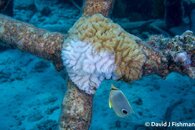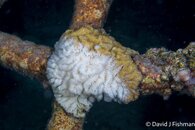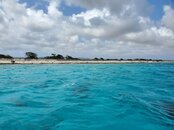Hi Martijn. Do you have any update on this meeting? Thanks
From the Bonaire Reporter, 6 hours ago:
In case you missed this...unfortunately we missed a few lines in our printed version of the Reporter resulting in an incomplete read- sorry for the mistakes. The online version is corrected or you can read it here.
STINAPA HOLDS UPDATE ON SCTLD
STINAPA Bonaire’s April 28 update meeting regarding Stony Coral Tissue Loss Disease (SCTLD) received the full attention from the dive and watersports community with the announcement of 10 northern dive sites closing and no diving in Washington Slagbaai National Park (WSNP).
STINAPA biologist Roxanne-Liana Francisca provided background of SCTLD and the seriousness of the problem.
SCTLD is one of 25 coral diseases with causes unknown that have infected Caribbean corals. Until SCTLD, white band disease made the largest impact destroying 90-98% of staghorn and elkhorn coral across the Caribbean. Where white band affects only two coral species, SCTLD can attack 20.
A test for SCTLD has not been found therefore a diagnosis is never 100%. Only one symptom is reported – they turn white and then die. The disease is most likely a bacteria that progresses very quickly advancing by 3-4 cm per day with a potential for devastation.
Francisca said, “White patches appear and move really fast. Other diseases take months or years, but SCTLD can kill coral colonies in days or weeks. Treatment with antibiotics can kill it but that doesn’t mean it won’t spread throughout an entire colony.”
The disease was first spotted in 2014 at the Port of Miami and moved to Jamaica, Trinidad/Tobago, Haiti, Cuba and other Caribbean islands. Florida has received 60% loss with a reported 400 miles of coral reef affected. Currently St Maartin reports a 90% loss, Curacao and Bonaire corals are infected but not Aruba.
In 2022, STINAPA discovered a disease affecting pillar coral but as to whether it was SCTLD was never confirmed. In February similar symtoms were noticed on Maze coral on Calabas reef.
“We are not blaming anyone and most likely we will never know, but it doesn’t matter, it is here, and we are trying to combat it. It’s our job to try to control it.” said Francisca “One week we find 48 infected corals and the next week there are 60 corals. But 87% of the reef is still healthy. We should all take this very seriously.”
STINAPA has reacted in phases: Phase 1 was to alert and inform; Phase 2 is present guidelines and monitoring and Phase 3 is active intervention.
The disease has spread over 2.5 km with very little mortality. Francisca suggests it could be that overall Bonaire has healthier corals than other islands with an average of 40% coral cover while other islands have only 18%.
Francisca noted that higher temperatures slow the spread of the disease. Whether or not small fish pecking the coral could spread the disease is unknown. But it is clear the disease accumulates on neoprene wetsuits and other gear requiring disinfection protocols for divers and snorkelers.
Francisca explained that the disease is already in the water column. Currents move the water and where the currents meet it pushes the water out and much of the polluted water is going north. (see map)
This is why the northern dive sites on the west coast were closed May 1: Carel’s Vision, Taylor Made, Candyland, Nukove, Wayaka, Slagbaai, Bisé Morto, Playa Funchi, Playa Benge and Boka Bartol. Moorings on these sites have been removed to prevent boats mooring. Swimming and snorkeling are allowed.
A marine park boat is stationed at Karpata to monitor possible illegal diving. Any vehicles entering WSNP will be checked for dive gear and removed if found and left at the entrance to pick up later.
To hopefully curtail SCTLD on Klein Bonaire, it was announced beginning May 15, Klein would be closed to all boats after 2 p.m. This is to prevent infection from other Bonaire sites visited earlier in the day.
With these initial announcements meeting participants voiced their concerns regarding scheduling times for boats, loss of client bookings, income and even the cost of providing decontaminating tanks for their client’s gear.
Ernest de Lanoy, president of Piskabon, spoke to the crowd saying, “I’m afraid my grandchildren won’t be able to enjoy the coral. Few people here have offered support to STINAPA. Most are only concerned about their own business. I can imagine if it [the coral] dies they will pack up their business and go to a different island. If we don’t all work together then my first concern will come true.”
Since the April 28 meeting, SCTLD has been identified on Klein Bonaire at dive sites Jerry’s Reef, Just a Nice Dive and Buddy’s Reef. STINAPA is continuing to monitor other Klein Bonaire sites and will provide updates regarding their plan as to whether a 2 p.m. closure will be in effect beginning May 15.
Francisca said, “Decisions are based on limited data, but it’s the best data available from other island’s experiences. Bonaire reefs are very resilient. Our reefs are a lot healthier than other islands and we might be better able to fight all the disease. But if we do nothing, then we will lose our coral.”
STINAPA is holding monthly updates to keep everyone informed. But everyone must do their part. Disinfect your gear and follow the rinse protocol outlined at
A weekly updated map of the spread of the disease visit
https://www.agrra.org/coraldisease-outbreak/





